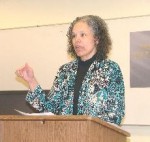
Grambling State University’s division of Academic Affairs and English department sponsored an Ann Petry symposium entitled on Monday, Jan. 26.”Bright Days, Foggy Nights: The Passion, Humor, and Pathos of Ann Petry’s Fiction” was the title of the symposium.
Petry, was a novelist, short story writer, author of books for children and juveniles, essayist, poet, and lecturer. She was born on October 12, 1908, in Old Saybrook, Connecticut.
She was the second daughter of Peter C. Lane and Bertha James Lane and grew up middle class in a predominantly white community.
Petry’s daughter, Elisabeth (Liz), was the featured presenter.
She is the author of At Home Inside: A Daughter’s Tribute to Ann Petry and Can Anything Beat White?: A Black Family’s Letters.
Petry presented from her mother’s short story “New Mirrors” and book the Narrows.
After words of welcome from Dr. Jennifer McMullen, Interim Chair for the English department, the moderator, Nyomi Lyttle, introduced Dessie Sanders.
Sanders delighted, captivated and amazed the audience and guest speaker with her singing and dramatic reading of “Surrogate Mother,” chapter two in Liz’s book Can Anything Beat White?: A Black Family’s Letters.
McMullen said of Sanders’ performance, “She made Bertha, Liz Petry’s ancestor, come alive. I applaud her. The audience definitely appreciated her dramatic reading. More specifically, Liz Petry was noticeably affected by Ms. Sanders’ performance,” she said.
Petry was introduced by associate professor of English, Theresa Washington, who holds Ann Petry’s Endowed Chair of English.
who began by telling the audience that her mother had mother layers to her life and that she chose her theme because of the contrast of humor and light in the works.
She said, “My mother called the fog, soft, wet, and clinging. Something peculiar about fog is that it magnifies sound.”
Petry said the sound of the foghorn, that old men called Uncle Sam’s bull, could often be heard for many miles on foggy nights.
Then she explained the “code,” the way in which the family lived. She said that the family never let outsiders see their pain. She said “the entertainer does not let the audience know that he or she feels pain.”
One interesting fact she mentioned about her mother is that she did not make much of an effort to disguise names in her works and that one of her characters, Link Wilson, bears resemblance to Liz’s father.
Also, within her mother’s works are events that actually occurred. “My grandfather really did disappear for a day when he got his new teeth. However, my mother was not a child. She was 37 and was not present when this event took place,” said Petry.
“In 2009, my mother could not have written the Narrows in the same way. It was published in 1953, a year before Brown vs. the Board of Education. Also, during the time of the Narrows, jobs for black were menial, except for black business owners in black neighborhoods.”
Petry talked about how her mother destroyed her letters and papers during this era because of the House Un-American Activities Committee’s investigations.
The HUAC was originally established in 1937 under the chairmanship of Martin Dies, and its main objective was the investigation of un-American and activities geared towards overthrowing or destroying the government.
Dr. Robert M. Dixon, Provost and Vice President for Academic Affairs, said that it is important to sponsor activities such as the Ann Petry symposium because “they provide role models for our students.”
This was echoed by McMullen, “As educators we want to introduce students to outstanding scholars and scholarship; Dr. Liz Petry exemplifies such.
She said that Petry’s presence at GSU created an opportunity so that faculty and students were enlightened about two significant authors-Ann and Liz Petry.
“I am impressed with Liz as author and scholar. Her critical work and presentation stress the importance of history, family and the written word. She draws from the past to create scholarship that inspires readers to examine their own lives.”
Dr. Beatrice McKinsey, associate professor, served as the committee chair for this program.
She said, “(Ann) Petry’s work is very interesting. She is a very quiet speaker in her story. She doesn’t say much; she just tells the story and lets the readers draw their own conclusions.”
This seems to be a trait that Liz inherited from her mother – the ability to draw in the audience and make them think about the work.
Lyttle, an English education major, said that what she liked most about Liz Petry’s presentation is that she did not simply discuss the works. “She gave us some insight into them, just enough to intrigue us and make us want to read them.
